We take a look at the careers of the ten greatest baseball players of all time. This list does not include pitchers, which is a story for another time.
The great game of baseball
Baseball has everything – anticipation, unpredictability, drama. It requires high intelligence and quick thinking to play it well. Baseball has never quite caught on in Europe, but in most of the rest of the world, it is wildly popular, especially in Japan, Taiwan, Korea, and all over Latin America.
Our list of the top ten ballplayers of all time consists, except Albert Pujols, mostly players who have long since retired. Barry Bonds, despite his awesome statistics, is not on the list, and neither is Mark McGwire, because their steroid use not only helped skew their statistics upward, it demeaned the very integrity of America’s national pastime.
Jackie Robinson – No. 10
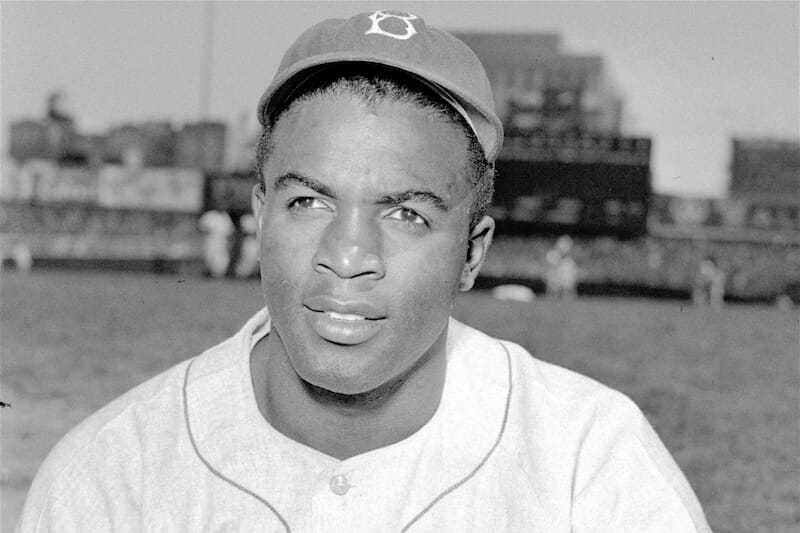
Our list begins at number 10 with Jackie Robinson. In some ways, it could be argued that Jackie Robinson should be at the top of this list, given the pressure that was placed upon him and the vitriol that was directed at him when he entered major league baseball as the first black man to ever play there, which he endured in dignified silence. Many of his teammates shunned him at the start of his career, but he quickly earned their respect with his stellar play at second base and his batting. In Florida, where the Dodgers went every year for spring training, Robinson had to endure being segregated from his teammates, eating at ‘colored only’ restaurants, and staying at black hotels.
Robinson was a star high school athlete, brought up by a single mother, and went to UCLA on a football scholarship. At UCLA he became the first athlete ever to earn letters in four different sports: football, basketball, baseball, and track. He was elected to the All-American football team as a senior at the halfback position.
Robinson was commissioned a Second Lieutenant in the Army in World War II, but he received a court-martial for refusing to move to the back of a segregated bus during a training exercise.
Jackie Robinson played eleven years in the major leagues with the Brooklyn Dodgers, where he was named Rookie of the Year in 1947, won the batting title by hitting .342 and the National League Most Valuable Player award in 1949. He had a lifetime batting average of .311. He was also a superb fielder at the second base position and his baserunning was electrifying.
Robinson became the first African American to rise to the position of Vice President of a major American corporation after he retires from baseball, with Chock Full-O-Nuts Coffee. He also became active in the civil rights movement, marching with Dr. Martin Luther King, Jr. in 1963’s March on Selma, Alabama.
Major League Baseball, in honor of Robinson, has permanently retired his number, 42.
Albert Pujols – No. 9
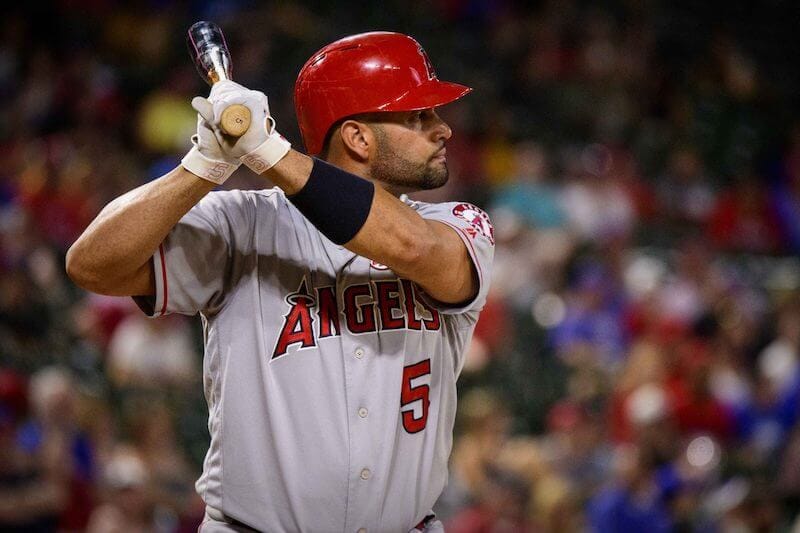
Albert Pujols, currently playing third base for the St. Louis Cardinals, could conceivably end up at number one or two on a list like this, if he keeps hitting at the pace he has throughout his career, now in its eleventh year. He has amassed 415 home runs as of this writing, averaging over 40 a year, and he could pass Hank Aaron’s record (Barry Bonds doesn’t count) by the time he hangs up his spikes. Pujols has hit over .300 in ten of the eleven seasons he has thus far played and owns a lifetime batting average of .329, the highest of any active player in the major leagues.
Willie Mays – No. 8
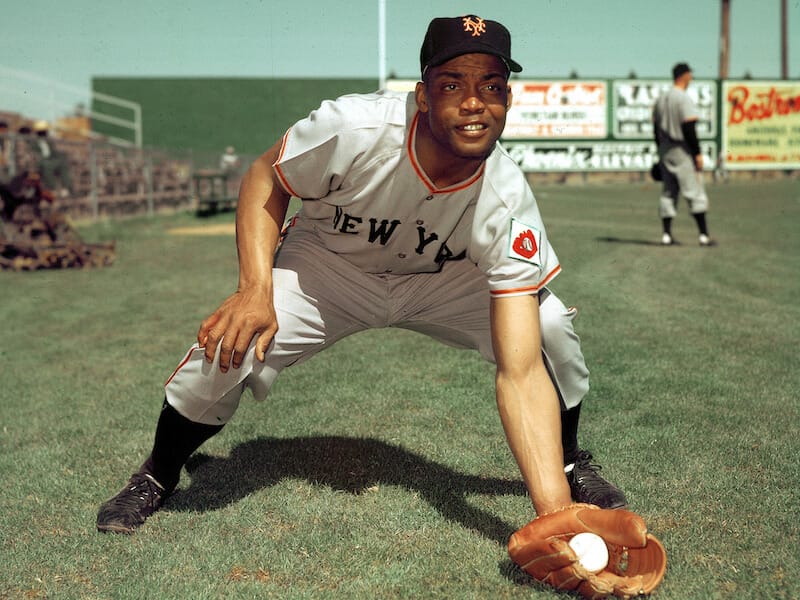
Willie Mays, the “Say Hey” kid, was as electrifying a ballplayer as ever played the game. He was a great center fielder, and his back-to-the-plate, running flat out, over the shoulder catch of a long Vic Wertz line drive in the 1954 World Series is seen as the greatest catch ever made. He was a magnificent base runner, and he led the league in stolen bases five times in his career, which spanned 22 years. Mays had a lifetime batting average of .302, hit over 50 home runs on two occasions, and his total of 660 home runs is behind only Hank Aaron’s 744 and Babe Ruth’s 714. Leo Durocher, his longtime manager and never one to heap praise on anyone, said Willie “is my kind of ballplayer.” Coming from Durocher, that was the ultimate compliment.
Joe DiMaggio – No. 7
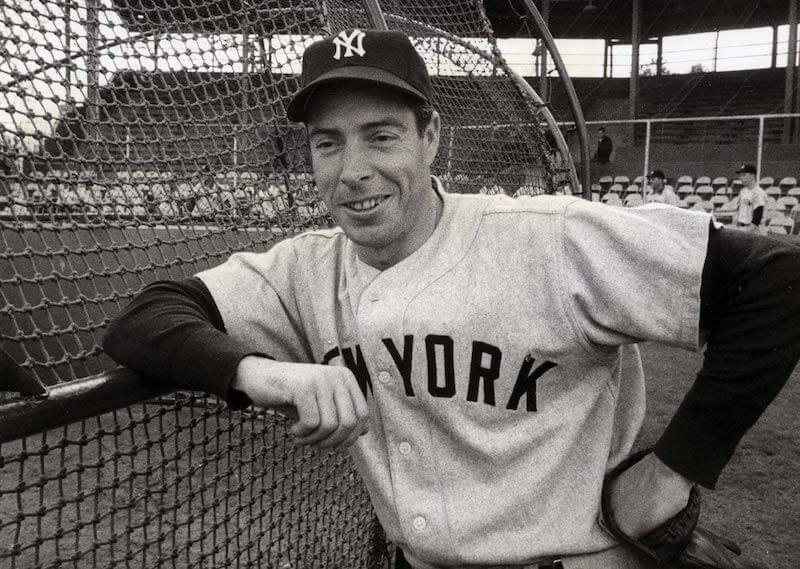
“Joltin Joe’ DiMaggio played his entire 13-year career for the New York Yankees, from the late 1930s to the early ’50s. In his second year, he drove in an astounding 167 runs. He led the league in home runs on two different occasions and twice earned the league’s Most Valuable Player award. DiMaggio owns what most regard as the greatest single achievement in baseball history, and some regard as the greatest record in all of the team sports, a fifty-six game long hitting streak. What most people are unaware of is that DiMaggio’s streak was stopped when Ken Keltner, third baseman for the Cleveland Indians, made not one, but two incredible plays on screaming ground balls that Joe had hit along the third baseline and succeeded in throwing him out. DiMaggio went on the next day to begin an eighteen game hitting streak.
Joe DiMaggio was a superb center fielder and a great base runner as well. He possessed uncommon speed, both in the field and on the base paths; his long loping stride was a thing of beauty, almost making him appear as if he were running in slow motion.
Stan Musial – No. 6
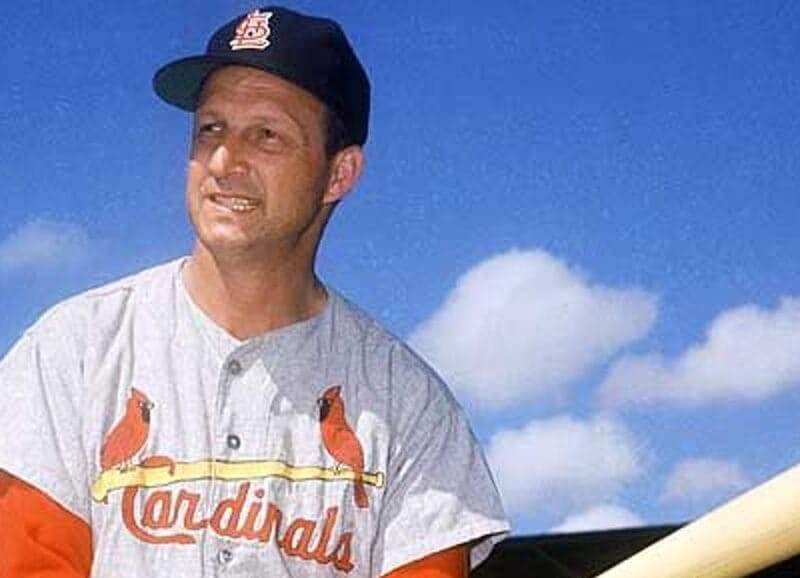
Stan “The Man” Musial played his entire career for the St. Louis Cardinals spanning twenty -three years and three decades at first base and in the outfield. Not known as a pure power hitter, Musial still amassed a total of 475 home runs throughout his tenure in the big leagues. Musial batted under .300 only once in his career, and his lifetime batting average was a lofty .331. He was as consistently good at the plate as any batter in the history of the game.
I remember seeing Musial interviewed on television once, years after his retirement, by Joe Garagiola, a former teammate of Musial’s who had become a broadcaster. Garagiola asked him, “Stan, who were the pitchers you feared the most?” Musial broke into a big smile and answered, “Joe, I feared none of them. I could hit ’em all.”
Hank Aaron – No. 5
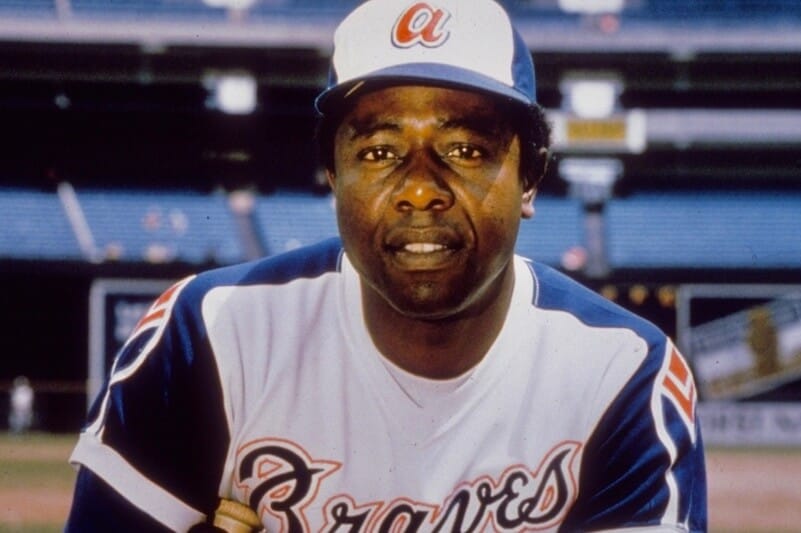
“Hammerin” Hank Aaron, Henry, played his entire twenty-three-year career with the Milwaukee and Atlanta Braves from 1954 through 1976, amassing a lifetime batting average of .305. He led the league in batting average four times, in-home runs four times, and in runs batted in four times. He was elected to the National League All-Star Team in twenty of his twenty-three seasons. Hank holds the record for career runs batted in at 2297 and total bases at 6856. His career home run record, though, is most amazing. Forty-seven was the highest number of home runs he hit in any one year, but his year-in, year-out consistency in this department gave him the astounding total of 744 throughout his career. Hank had the quickest wrists in the game, which allowed him to wait until the last possible millisecond before he would commit to swinging at a pitch.
Hank Aaron was not only a great ballplayer. He was also the consummate gentleman, on and off the field. After he broke Babe Ruth’s home run record he said, “I’m hoping someday that some kid, black or white, will hit more home runs than myself. Whoever it is, I’d be pulling for him.”
Rogers Hornsby – No. 4
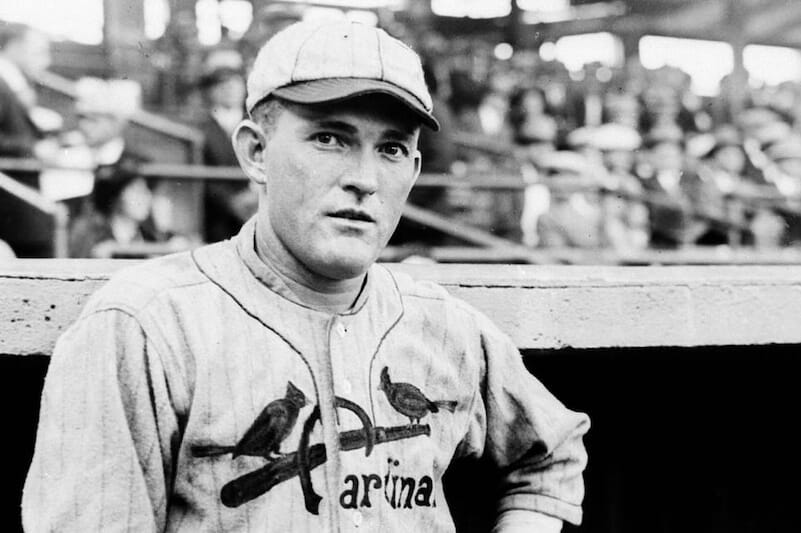
Rogers Hornsby played twenty-three years in the major leagues with six different teams, most of them with the St. Louis Cardinals and Chicago Cubs. His lifetime batting average over those years was an astounding .358, and he owns the highest single-season batting average in the history of baseball, a whopping and almost inconceivable .424. He hit over .400 in three different seasons and had averages of .397 and .387 in two others. It could be argued that he was simply the greatest hitter who ever lived.
Ted Williams – No. 3
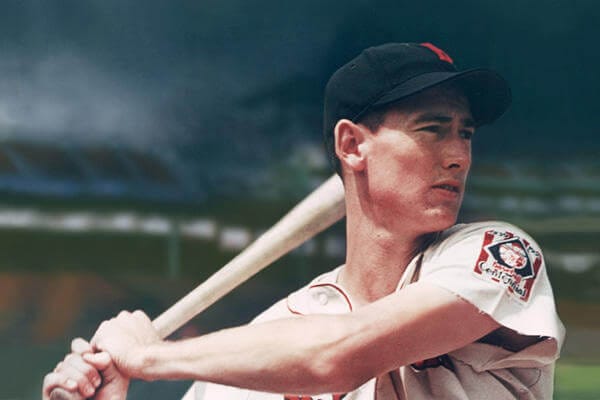
Perhaps a truly objective observer would place Rogers Hornsby in the number three position, but my bias as a rabid Boston Red Sox fan prevents me from doing that. I had the pleasure to see Ted Williams play, and his presence and charisma on the field were electric. He owned the prettiest swing ever seen. Teddy Ballgame,The Thumper, Terrible Teddy, and The Splendid Splinter were just a few of the nicknames that revealed the respect he carried as a player.
Ted Williams played for the Boston club from 1937 through 1960, missing three years during World War II and another year during the Korean War, when he traded his spikes for a seat in the cockpit of a fighter airplane. If Williams, as well as Joe DiMaggio, had not missed perhaps what would have been their most productive years in baseball due to war, there is no telling the records they might have amassed.
Williams was the last player in the major leagues to bat over .400 in a single season, and his lifetime batting average was .344. He hit 521 home runs in his career, never more than 38 in a season. Thus he was a model of consistency as a power hitter. What is most amazing to this observer’s mind, however, is that he hit .388 when he was thirty-nine years old – four more hits and it would have been .400.
The year he hit .406 – 1941 – the Red Sox were playing a doubleheader on the last day of the season, and his batting average going into play that day stood at .3995, which rounded off would count as being an even .400. His manager offered to sit him down during the doubleheader and not play him, thus assuring Ted he would go into the history books with an average of .400. Williams flatly refused to sit out the day on the bench and promptly went out and got six hits in eight at-bats in the two games to raise his average to .406.
In 1948, Lou Boudreau, the manager of the Cleveland Indians, invented the ‘Williams shift’, which placed the shortstop in the second base position and the second baseman in short right field, because Williams was a dead pull hitter, always hitting the ball to the right side of the field. Over the rest of his career Williams refused to alter his stance or swing to try to hit to the opposite field, and the shift, which all the other teams subsequently adopted against him, robbed Williams of countless hits. There is no telling what he would have accomplished had not Boudreau invented the shift.
When Williams was twenty years old he said “All I want out of life is that, when I walk down the street, folks will say, “There goes the best hitter who ever lived.” Joe DiMaggio said of Williams, “He was, quite simply, the best hitter I ever saw.” And Williams, once having hit a double to drive in two runs, then scoring on a single, came back into the dugout and said to Johnny Pesky, his best buddy on the team, “Pesky, ain’t I the best-damned hitter you ever saw?”
Ty Cobb – No. 2
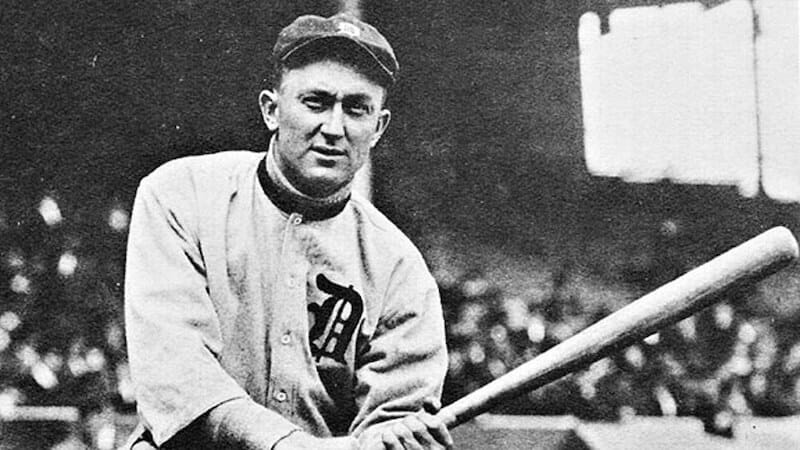
Ty Cobb on the baseball field was meaner than a junkyard dog. He would come flying into second base on a ground ball or a steal, spikes flying, hell-bent on turning the second baseman into a cripple. Not many people liked Ty Cobb, even among his teammates, but they could not help but respect him. Cobb came to the majors in 1905, and in a very abbreviated year when he only batted 150 times, hit for an average of .240. For the next twenty-three years, through the 1928 season when he retired, he batted over .300 every year, usually way over .300. He won the league batting average championship a whopping eleven times, a record which still stands and is perhaps, along with DiMaggio’s 56 game hitting streak, the record least likely ever to be broken. He finished his career with an all-time high lifetime batting average of .366.
Babe Ruth – No. 1
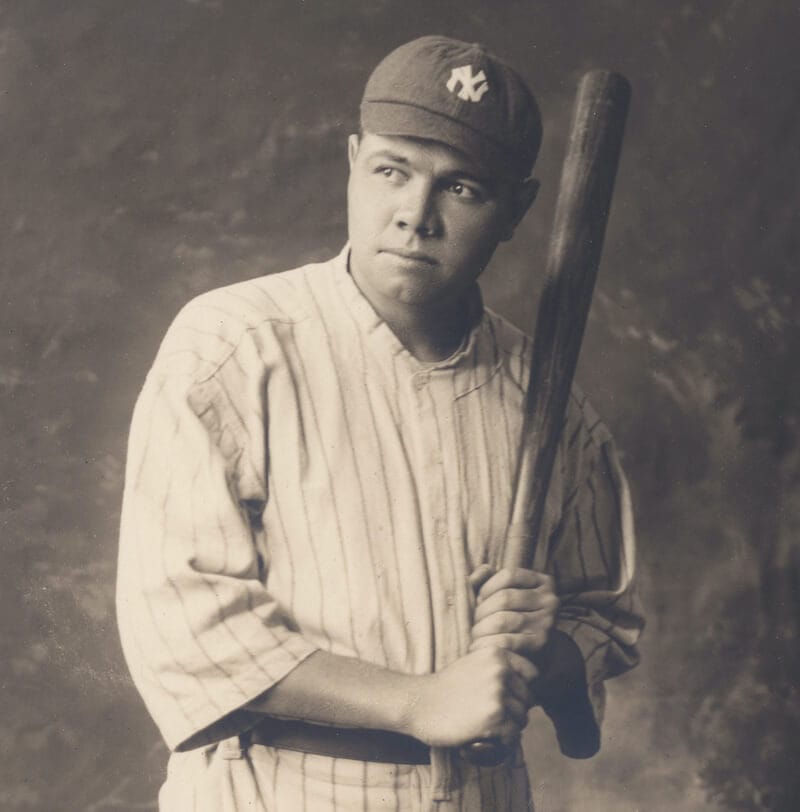
George Herman “Babe” Ruth grew up in an orphanage in Baltimore, and played ball on the streets, much like Willie Mays, in his youth. Babe, nicknamed the Bambino and the Sultan of the Swat, started his 22-year career with the Boston Red Sox as a pitcher, and a great one at that. He won 96 games as a pitcher against only 46 losses, and in the 1916 World Series set a record by pitching 18 and 2/3 consecutive scoreless innings, a record which stood until Don Drysdale broke it many decades later. He also led the league that year with an astounding earned run average (ERA) of 1.75.
The owner of the Red Sox sold Ruth to the New York Yankees at the end of the 1918 season for $100,000, because he was broke. Red Sox fans have regretted it ever since.
Ruth’s lifetime batting average was .342, fourth all-time behind only Cobb, Hornsby, and Ted Williams. He hit for a record .660 slugging average throughout his career, and his 714 home-run total in the era of the ‘dead ball’ was nothing less than astounding. His single-year record of 60 home runs, set in 1927, stood until Roger Maris broke it in 1961, during a season that included 162 games as opposed to the 144 game season played in Ruth’s day.
Ruth was as legendary off the field as on. He was paid one hundred thousand dollars a year in his prime when the average salary of a baseball player was around thirty-five hundred dollars, and it allowed him a lavish lifestyle. He was famous as a two-fisted drinker and partier, and he could consume mountains of food in a single sitting. He once ate thirty-six hot dogs before a doubleheader and then went out and blasted three home runs that very afternoon.
Not on the list
I had a hard time leaving Mickey Mantle off this list, as well as Honus Wagner and Tris Speaker. You could even argue for the likes of pure hitters such as George Brett, Wade Boggs, and Tony Gwinn, but I think this list, in the final analysis, honors the very best that ever played the game.
